
Harrow and Hillingdon Geological Society
Energy for the Future
Home | Monthly Meetings | Field Trips | Exhibitions | Other Activities | Members Pages | Useful Links
Geology of energy policy in the UK (with reference to shale oil and shale gas)
Tony Grindrod
Introduction
There are 3 major considerations for the future, the population explosion, energy poverty and water availability and quality, along with climate change and the Kyoto protocol.
In 1970, world population was 3.7 billion and oil cost 5$/barrel (1 barrel = about 35 gallons). By 2013, the world population was 7,176 billion and oil cost 110$/barrel.
As far as energy sources are concerned, nothing can be ruled out. All energy sources entail risks and some problems. The wide range of sources includes oil, gas, coal, hydroelectricity, wave/tidal power, geothermal energy, biomass, wind, solar and nuclear. The US energy mix is dominated by oil, gas and coal. Recent years have seen a massive increase in shale gas from less than 1trillion cubic feet (TCF) to about 8TCF. Oil and gas producers prefer sandstones and limestones with high porosity and permeability but recently tight gas has also increased. Coal bed methane is not an enormous resource but it could make a contribution. By 2030, a massive expansion in US ahle gas is forecast.
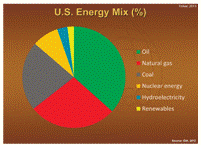
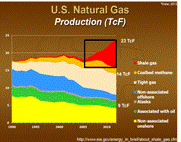
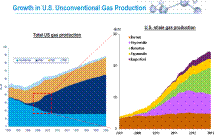
Requirements for shale gas success include:
• private ownership of land;
• low population density;
• developed infrastructure;
• agile independent exploration companies;
• listening banks;
• availability of drilling rigs;
• availability of fracturing equipment;
• availability of highly skilled personnel;
• low-cost high-technology wells; and
• identification of the core of the ‘play’.
As far as northern England is concerned, only tiny parts of the licensed areas may be commercially productive. Shale gas production requires the ‘right shale’. Many shales are poorly drained often fissile material, which are light grey in colour and not very interesting. However, a lot are black or dark grey, indicating the presence of organic matter (a prequisite for gas/oil generation). A lot of shale have phyloosilicates (clay minerals) but you also need silica or carbonate and organic material.
Some of the problems elsewhere include
• high population density (UK, France);
• government policy (France, Ukraine);
• land ownership (UK);
• water shortage (China, Australia, South Africa);
• abundance of conventional oil and gas (Saudi Arabia, Qatar);
• complex geology (Poland); and
• weak economy (Argentina);
• everywhere but North America wells are high-cost;
• everywhere but North America there is a shortage of drilling rigs, fracturing units (92% of which are in the USA) and skilled personnel; and public opinion and infrastructure.
Europe differs from the US in having generally higher population density, mineral rights retained by government, higher costs and limited service industry (about 100 land rigs in Europe compared to 2,000 in the US) and a society less familiar with land operators. Licenses issued by government give more control over companies selected. Larger license areas with less emphasis on early production can lead to more efficient development and Europe and the rest of the world can benefit from the advances in technology coming from the USA.
The BGS/DECC report Carboniferous Bowland Shale gas study: geology and resource estimation indicates that “the assessment of shale gas resources in the UK is in its infancy”. As an illustration, the UK sector of the North Sea has had just over 11,000 wells drilled, onshore shale gas has had 6. There is currently very little data and shale gas production needs the right shale in the right place and which has been buried to such a depth as to generate oil and gas. UK shale gas could be a significant resource and the estimate for the Bowland Shale is 1,329TCF. Recoverable resources have not been estimated due to technical and commercial uncertainty. Ultimate recovery can only be evaluated through exploration and pilot testing. This compares to the US Energy Information Administration estimate of 7,299TCF of technically recoverable shale gas in 42 countries, the top 3 being China, Argentina and Algeria but there has been little or no exploration in most countries assessed. The International Energy Agency estimate that Europe has 530TCF of unconventional gas resources.


In the UK, 6 wells have been drilled:
• Preese Hall 1 16 August 2010 to 16 April 2011
• Grange Hill 1 15 January 2011 to 15 April 2011
• Grange Hill 1Z 15 April 2011 to 9 February 2012
• Becconsall 1 23 August 2011 to 13 October 2011
• Becconsall 1Z 13 October 2011 to 21 December 2011
• Anna’s Road 1 6 October 2012 to 21 November 2012
Other data includes some seismic data but it is often of poor quality and the lines are widely spaced. It is difficult to image small faults. Other wells drilled onshore have been for either coal bed methane or conventional oil and gas. Real detail of the tectonics is essential for shale gas production.
Shale is a fine-grained sedimentary rock (siltstone/claystone) which splits easily (is fissile). The mineral composition is extremely variable but may include clay minerals, quartz, and carbonates. Shale oil is produced when organic matter within a sediment is buried and heated. Deeper burial may generate shale gas. Rocks are often naturally fractured but not always. To get oil and gas out requires fractures and these are very difficult to quantify and model. Unconventional oil and gas also includes gas hydrates. Typically, unconventional oil and gas production rises rapidly and declines equally rapidly so lots and lots of wells are required. Shales have very low porosity (fractions of 1%) and permeability (nanodarcys for a characteristic normally measured in millidarcys) and the trick is to release the oil and gas. Unconventional reservoirs are easy to find but expensive to produce.
North American shale plays - Exploration is now moving towards oil rather than shale because the fall in the price of gas makes it less profitable, while some shale oil is workable with an 80$/barrel oil price.
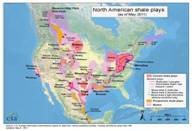
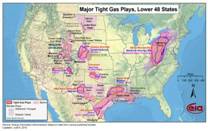
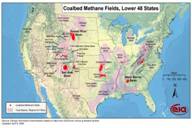
Reducing surface disruption
From one drilling site, it is now possible to drill down and to deviate wells laterally to follow shale. For example, at a site near the University of Texas at Arlington, just outside Dallas, 22 or 23 wells have been drilled from each site. Drilling time and cost has gone down in the USA and there have been some problems, especially in Pennsylvania, which is an area which has already suffered from many years of coal mining. The speaker’s main concern with the flaring of gas in shale oil areas such as the Bakken/Eagle Ford fields, which is a significant source of light pollution and unnecessary carbon emissions. Re-injecting the gas would be preferable since it is less environmentally damaging and it enhances oil recovery.
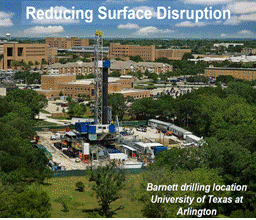
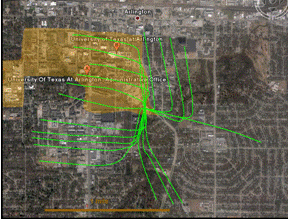
Shale gas in the UK
The main problems are:
• social licence to operate;
• land ownership;
• subsurface ownership;
• population density;
• paucity of data;
• high well costs;
• shortage of drilling rigs and fracturing units;
• shortage of highly trained operatives; and
• poor modelling of geology/reserves (too early).
Shale myths and misunderstanding include:
• Shale Gas drilling causes earthquakes – Yes the drilling of Preese Hall No 1 well did cause 2 very minor earthquakes which were felt by 2 or 3 people in Blackpool but larger ones have been caused by coal mining in many areas of Britain and a natural earthquake in the Irish Sea of magnitude 3.3 (larger than the fracking induced ones) was feltin Bangor, north Wales, the Isle of Man, Barrow in Furness, Blackpool, Fleetwood and Liverpool was virtually ignored by the media.
• Fractures go up from shale to surface – No, the maximum distance up or down of induced fractures is about 10m.
• Fracking contaminates groundwater – No known examples have been found of groundwater contaminated by fracking.
• Wells leak – There may be some examples of this but generally the drilling operation is tightly controlled and most US producers are acting ahead of legislation.
• Fracking fluids include poisonous chemicals – No, typical fluids might include a weak acid and a surfactant.
• Drilling causes noise, extra traffic – Yes
• Flaring of gas causes light pollution – Yes and this should be avoided.
Fracking sites are about the size of a football pitch and can tap a significant area outside that. However, the social licence to operate is not a given. This is well illustrated by the demonstrations that accompanied Cuadrilla’s drilling at Balcombe in Sussex.
Balcombe
The Balcombe No. 1 well was drilled by Conoco in 1986 and produced cores of Middle Jurassic Great Oolite with abundant hydrocarbons but was not taken up for farther exploration or development. There are other oil and gas fields in south-east England and Cuadrilla were drilling for conventional oil deposits (not for fracking). However, what started s small local demonstrations turned into a media circus, which eventually turned violent. The biggest single problem is that public perception is often shaped by images. For example, the Gasland film produced by opponents of fracking in the USA incorrectly attributes several cases of water-well contamination in Colorado to oil and gas development when investigations by the State of Colorado Oil and Gas Conservation Commission demonstrated that the wells in question contained biogenic methane that is not attributable to such development. Also the common media representation of fracking carefully labelled “not to scale” drastically reduces the apparent distance between the fracking horizon and groundwater and lacks detail in showing the multiple layers of steel casing and cement used to protect groundwater.
Conclusion
In conclusion the speaker saw no reason to change the view expressed in 2003 that “We do not expect large scale, commercial production of Shale Oil and Shale Gas outside the USA and Canada before 2030”
If he were asked – “Is there anywhere you would not explore for Shale Oil and Shale Gas?” his response would be:
• Anywhere I could not make a profit;
• anywhere we were not wanted by land-owners and general public; and
• anywhere drilling was likely to impact the surface environment